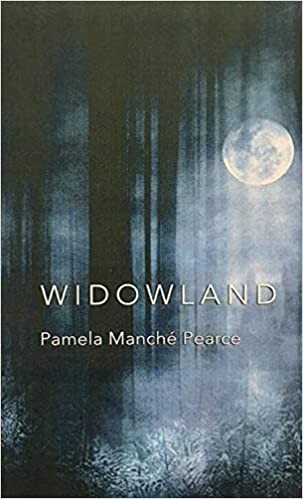
Widowland by Pamela Manché Pearce. Green Bottle Press, 2018. 36 pgs. £6.00.
Over the last decade or two, small publishers have again begun to emphasize the chapbook, a form I have come to love for its focus and variety and quirkiness. I appreciate chapbooks most when their brevity enhances the work, when the work circulates around a particularly narrow theme or topic—that is, when the material is unified—rather than when a poet publishes a chapbook simply because he or she isn’t yet prepared to publish a full collection.
Widowland by Pamela Manché Pearce explores the related themes of death and grief, memory, and the solitude of widowhood.The poems vary in style, form, and tone, yet they are united through these thematic concerns. Whether or not Pearce is finished writing about her husband’s death (I suspect not, for who among us ever is finished with such an experience?), the poems here belong together, and the chapbook is their perfect form.
The opening poem, “Tree of Cardinals,” is one of the strongest in the collection and introduces the idea of “widowland” with remarkable subtlety. The imagery revealss how memory can both disturb our temporal stability and also help convert grief into something like joy. Here are the opening stanzas:
I stand
in my dead husband’s
study and look
out the window
at an expanse
of winter.
I focus
on a small
bare tree,
a tree
of bones.
I imagine
a cardinal
there,
an ornament
on the barren
branches.
A voice tells me
I can have
a cardinal
and one appears.
Then it says
I can have
as many cardinals
as I want.
Were it not for the single adjective in the first sentence, “dead,” reinforced by the metaphor at the end of that stanza, “of bones,” the poem would have a much less layered meaning. Yet the speaker does again not mention her husband, his death, or even his study as the poem proceeds. Perhaps “the voice” is his voice; perhaps such an idea is only wishful thinking. Still, she receives a promise, regardless of its origin, and the promise is fulfilled. The poem proceeds imagisticly, a tree outside suddenly “ablaze / with small / crimson / birds.”
Then the controlling image of the poem shifts from the caalrdinals specifically to their color:
What is red?
What is red to me?
Everything that blood is.
Red is the fabric
apple stitched onto
my first-day-of-school
dress,
and the real one
my grandfather has
shined
for my teacher.
It is the color of his
cracked fingertips
that smell of
gasoline as he
cups my face to
kiss my hair
goodbye.
I have
as many cardinals
as I want.
So concludes the poem, with the speaker’s recognition that life is filled with promise, even in the midst of mourning. Imagine how differently this poem would read if it had ended with the penultimate stanza and the word “goodbye.” Presumably, the grandfather is long dead, too, and the goodbye he offered that day presaged many others. Yet the poem ends not with loss but with pops of color, with beauty and gratitude.
Another of my favorites in this collection is a prose poem, “Temple.” Its contents are strange, almost surreal, except the setting is real. The speaker’s perceptions and her translation of her observations into language create the surreal feeling for the reader. “Temple” opens with a statement that is nearly preposterous: “It might have worked: taking his cremains to the Metropolitan Museum of Art and placing them in the coin and medal cabinet of King George III.” How could a reasonable person think such a thing? The speaker isn’t exactly unreasonable, but she is grieving, and nothing in the world appears reasonable to a person in the early phases of grief. She finds herself in the wrong gallery, however, and sees “Portrait skulls and reliquary guardians with bared teeth and hats of turtle shells and mouse bones. Masks howling with human hurt and loss, streaked with soot and mud that smelled like radiation fire. The vacant eyes on a death mask, cleverly stuffed with cowrie shells then stitched down with sinews of pig, then ringed round and round with the red dust of butterflies. Heads. Heads. Heads.” The scene is undeniably memorable, as are most museum exhibits focused on death rituals of cultures not our own. These objects and the rituals they suggest might not be familiar to the speaker, but the emotions they represent are, for she concludes the poem waiting to be consumed: “To bring me to my knees as a sacrifice to my original being as a bird, a pebble, a beach. To rush me and his ashes down a river of sorrow and blood.” Though she remains alive, her body enfleshed and enlivened with spirit, she expects, even longs, to share her husband’s fate.
These two poems represent the range of tone and style of the collection. Though the seventeen poems here are thematically united, each poem is new. The speaker explores not only what more can be said, but how else she can say what she needs to say. Widowland can be read quickly but should be read slowly. It’s a rewarding collection.
